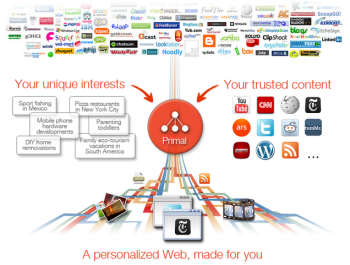There’s a Graph for That!
According to Murthy Nukala, “any marketer who doesn’t have a graph within the next twelve months will be at a permanent competitive disadvantage.” That’s a pretty ominous warning, particularly when most marketers have no idea what a graph is, let alone how to use it.

Graphs are a useful way to represent relationships between things. And the World Wide Web is called a Web for a reason: it is a huge network composed of pieces of content and links among them. So it isn’t surprising that graphs are being used everywhere in IT these days to represent particular kinds of relationships among types of content living on the Web.
Since every kind of relationship among things on the Web seems to have its own graph, it can get a little confusing keeping them all straight. That also makes it hard to determine which of those many graphs could be important to you and your business.
You might find it all befuddling enough to develop graphophobia and just ignore them all. That would be a shame, because leveraging these mysterious graphs could truly revolutionize your business.
Here I’ll connect some of the dots and help you understand what graphs are and why they are important.
Here a Graph, There a Graph, Everywhere a Graph, Graph
Where do we start? Well, let’s begin with the current Mother of All Graphs, the Social Graph — made famous by giants such as Facebook and LinkedIn.
Social Graphs connect people to other people — for example they connect businesses with their customers. Unless you’ve been living under a rock for the past 5 years, their importance in today’s business environment is pretty obvious.
There’s another prominent graph, probably more well-known for who is building and using it than what it actually is used for: Google’s Knowledge Graph. The Knowledge Graph relates instances of things to the classes or categories to which they belong. For example, Santa Cruz is a Place. We could get more specific and say Santa Cruz is a City (which is both a Place and a Unit of Government).
This kind of graph data provides useful background knowledge. The data can help improve the ease of use and accuracy of searching (which is a compelling reason for why Google uses it). Knowledge Graphs also provide important clues for applications to use. For example, we can specify that Places have a geo-location, so a map-related application can expect to find GPS coordinates for any entity that is designated as being a Place1.
Google, by the way, does not have the only knowledge graph. The links in Wikipedia, DBpedia, and the multitude of Linked Open Data (LOD) models from the Semantic Web community are fundamentally knowledge graphs. Schema.org is standardizing how some of this information gets included as metadata associated with Web pages for use in SEO.
Coming on the heels of these two well-known kinds of graphs are many others, existing or proposed. For example, several additional kinds of graphs have been proposed in terms of how to organize all the big data being collected by wearable and other mobile devices. These include Consumption or Payment Graphs that relate people to their purchases, Intention Graphs that relate things like a smartphone gesture or the invocation of an application to some intended purpose, and Mobile Graphs that relate a person (or their mobile device) to all the sensory and other data collected by that device.
Hunch (acquired by eBay) and other similar services deal with a so-called Taste Graph that relates your preferences for one thing (for example expressed through a Like) to a prediction that you’ll like some other thing. Obviously this kind of predilection data has relevance for business uses such as product recommendation.
Some hybrid or blended graphs are even now also starting to come onto the scene, for example Social Interest Graphs. These graphs relate you to items of potential interest based on the behaviors, Likes, etc. of other people in your social network. They are built around an implicit assumption that if you spend a lot of time hanging out in social communities with friends who post frequently about, or explicitly Like, say movies, then you might be interested in movies, too. Similar assumptions can be made about skills and professional interests likely shared with people in your business social network. These graphs can therefore be useful for product recommendations, job recommendations, and recommendations about other people you might want to connect to (or even date!).
There are Opinion Graphs, Mood Graphs and well…the list of graphs just seems to go on and on — but fortunately for you I won’t.
Last but certainly not least, Interest Graphs relate people to the things that interest them or that they have an interest in. At Primal, we think Interest Graphs can be very useful and therefore quite valuable to many businesses.
And we’re not the only ones who think so.
Why Are Interest Graphs So Important?

With so many graphs that are useful for some purpose or another, you might well ask: Why are Interest Graphs so important?
Interests lie at the heart of many activities that people do, and people are typically passionate about their interests. Those activities and that passion form the basis for business opportunities of many kinds.
Let’s take Twitter as an example of a successful company built around interests. Most people would agree that Twitter is successful, at least based on their volume of usage, large ecosystem, and recent IPO. But where do interests come in?
It might not be obvious that Twitter is so into the interests of Twitter users, but in fact interests are the centerpiece of their business. The reality is, apart from celebrities with high name recognition and people in one’s existing social circles, people follow other people on Twitter not because of who they are, but because of the things they tweet about (“it’s the hashtags, stupid”). They start following someone because they share an interest with them, based on the topic(s) that person tweets about.
Furthermore, the set of people (and companies/brands) that a Twitter user follows indicates a lot about their interests, as do the topics they themselves tweet about or retweet. So at its heart, Twitter is built around user interests. Twitter derives Interests Graphs for its users by mining data about their behavior on Twitter.
That knowledge about your interests is money in the bank for Twitter. Literally! How much did they raise in that IPO?In their IPO filing with the SEC, Twitter even directly stated how important Interest Graphs are to their business (see the extract below):
We believe a user’s Interest Graph produces a clear and real-time signal of a user’s interests, greatly enhancing the relevance of the ads we can display for users and enhancing our targeting capabilities for advertisers.
At Primal, we think an individual’s interests are very valuable, too, and not just for ad targeting. Your interests say a lot about who you are as a unique individual. That makes them inherently valuable, as well as having important (and surprising) business uses.
Interest Graphs can be used to provide personalized content tailored to your individual customers (for example, users of your travel planning app or your sales contacts). They can also be used to ‘automatically curate’ content for content marketing and sentiment analysis, and to provide business intelligence for use in business development and sales activities. They can be used to recommend products, services, activities, events and people related to the interests of your customers, and to power knowledge-centered customer support. And yes, they can also be used effectively to target ads. The key is to not just stop at superficial representations of your customers’ interests such as simple keywords in user profiles, but instead to give your application a deeper understanding of the real meaning behind the words. Those deeper insights into what really sparks your customers’ interests will give your business an edge in attracting, serving and retaining customers and providing them with a truly compelling, and perhaps surprising, user experience.
Getting Started
Check out our developers site to get started generating value for your business from the use of customer interest data delivered by Primal through the innovative creation and use of Interest Graphs.
1 Note: we could make a distinction here between real-world, physical places versus fictional or imaginary places like Peter Pan’s Neverland that wouldn’t have a GPS coordinate, but we’ll save fine-grained points like that one for another time.